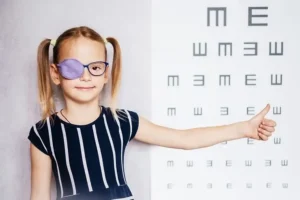Keratoconus is a condition in which the cornea starts thinning and bulges like a cone. Due to this the shape of the cornea changes leading to a blurred and distorted vision( nearsightedness, irregular astigmatism). Usually, this condition affects both the eyes. In severe cases, scarring or a circle is seen within the cornea.
Causes:
• Genetic factors
• Environmental factors
• Hormonal factors
• Family history of keratoconus
• Sometimes due to rubbing of the eyes and allergies
Classification of Keratoconus:
Degree of keratoconus is classified in several ways.
• Based upon severity the classification is as follows
| Sr no. |
Sevearity |
Keratometry Reading |
|---|---|---|
1 |
Mild |
<45.00Ds |
2 |
Moderate |
45.00-52.00Ds |
3 |
Severe |
>52.00Ds |
• Based upon the morphology of the cone the classification is as follows:
| Sr no. |
Morphology of the cone |
Corneal thinning |
|---|---|---|
1 |
Nipple |
small: 5 mm and near-central |
2 |
Oval |
larger, below-centre and often sagging |
3 |
Globus |
more than 75% of cornea affected |
• Based upon Krumeich classification:
| Stage |
Characteristic |
|---|---|
1 |
Eccentric steepening Induced myopia and/or astigmatism of ≤ 5.0 D |
2 |
Induced myopia and/or astigmatism between 5.00 and 8.00 D |
3 |
Induced myopia and/or astigmatism between 8.01 and 10.00 D |
4 |
Refraction not measurable |
The stage is determined if one of the characteristics applies.
Symptoms:
1. Asymptomatic (initially)
2. Defective vision (Frequent change in vision/glasses)
3. Distorted vision for distance and near
4. Ghosting/monocular diplopia (Doubling or shadowing of the image when viewed with a single eye)
5. Flare/glare (especially at night)
6. The image appears clear while squeezing the eye
7. Headache
8. Excessive eye rubbing
9. Dry eye
10. Eye strain
11. General eye pain
12. Sometime squinting of eyes etc.
Multiple images seen by a person with keratoconus in bright light condition.
Treatment of Keratoconus
Treatment for keratoconus ends with contact lens, as it cut down the aberrations and provide clear vision. Various type of contact lens options is available. The options include rigid gas permeable (RGP) lenses, soft and soft toric lenses, piggyback contact lenses (PBCL), Rose K2 contact lens, hybrid lenses and scleral lenses.
1. Soft contact lens
Soft contact lens is useful only in mild keratoconus, in moderate to advanced cases gas permeable lens is the best choice. A soft or soft toric contact lens is selected based upon the degree of keratoconus.
2. Gas permeable contact lens
The gas permeable lens is also known as a GP lens or RGP lens (rigid gas permeable) or hard contact lens. It masks the irregular corneal curvature forming a good refracting surface thus helps in correcting vision
3. Rose k2 Lens
The Rose K2 lenses are a set of lens series that has been designed to fit all corneal shapes, sizes and stages of keratoconus.
4. Piggybacking contact lens
In Piggyback contact lens soft and RGP contact lens is placed together on the same eye thus, providing the comfort of a soft lens and visual clarity of the RGP lens. This type of lens is fitted in people who is not comfortable with the RGP contact lens.
5. Hybrid contact lenses
As the name says these lenses are the combination of soft and RGP lens into a single lens. The centre optic zone is made up of rigid gas permeable material with a soft peripheral “skirt”. This design is intended to provide both comfort and visual clarity in people with keratoconus.
6. Scleral Contact Lens
Scleral contact lenses are larger diameter semisoft lens which rests on sclera (white portion of the eye). These lenses provide the best comfort as it does not touch the cornea, also with best visual clarity.
7. Intacs
Intacs are transparent, arc-shaped corneal inserts which are surgically placed within the peripheral cornea to reshape the front surface of the cornea for clearer vision. Intacs are needed when a person with keratoconus can no longer obtain functional vision with contact lenses. After the Intacs one may have to wear the spectacle or contact lenses.
8. Corneal crosslinking (for progressive keratoconus)
Corneal crosslinking also known as corneal collagen cross-linking or CXL. It strengthens corneal tissue to stop bulging of the cornea in keratoconus. The procedure is performed using ultraviolet rays ( UVA ) and a photosensitiser, Riboflavin. This enhances the rigidity of corneal tissue and stabilizes the condition.
Corneal crosslinking significantly reduce the need for corneal transplants amongst keratoconus patients.
9. Topography-guided conductive keratoplasty
Topography-guided conductive keratoplasty (CK) is a procedure in which the radio waves are directed in the peripheral cornea to reshape it. This a hand-held tool in which topographic “map” created by computer imaging of the corneal surface helps to create a customized treatment plan.
It is not as popular as other treatment options but may be helpful to reduce irregular astigmatism caused by keratoconus. After the procedure vision can not be as clear as contact lenses.
10. Corneal transplantation
In extremely advanced cases a cornea transplant, also known as penetrating keratoplasty (PK or PKP). It takes several months or years for the vision to stabilize after transplantation, and one will likely need glasses or contact lenses afterwards to see clearly. Post-transplant there is the risk of infection and graft rejection.
That’s why a cornea transplant is recommended only if no other keratoconus treatments are successful.
Email/Call us to provide you confidential advice and support to help you with any concerns you may have about the care we provide.






